Process for enhancing the absorbency of a fabric having conjugate yarns
a technology of conjugate yarns and absorbent fabrics, which is applied in the field of enhancing the absorbency of conjugate yarns and consolidated nonwoven fabrics, can solve the problems of not being as absorbent as the fabric described in the above-referenced patents, and achieve the effects of enhancing the absorption properties, and increasing the hydrophilicity of the polyester componen
- Summary
- Abstract
- Description
- Claims
- Application Information
AI Technical Summary
Benefits of technology
Problems solved by technology
Method used
Image
Examples
Embodiment Construction
The present product is created by subjecting a fabric comprised of splittable continuous conjugate filaments to successive treatments with acid and base. The resultant treated fabric has enhanced ability to absorb water, as compared with the untreated fabric and other drying cloths made of similar synthetic materials.
The present process includes the steps of: (a) treating the fabric with acid and rinsing; and (b) treating the fabric with base and rinsing. In one preferred embodiment, before treatment with acid or base, the fabric is subjected to high pressure hydroentanglement, as described in U.S. patent application Ser. No. 09 / 344,596, filed Jun. 25, 1999, which is commonly owned and is hereby incorporated by reference.
The term “polyamide” is intended to describe any long-chain polymer having recurring amide groups (—NH—CO—) as an integral part of the polymer chain. Examples of polyamides include nylon 6, nylon 66, nylon 11, and nylon 610.
The term “polyester” is intended to descri...
PUM
| Property | Measurement | Unit |
|---|---|---|
| pKA | aaaaa | aaaaa |
| pKA | aaaaa | aaaaa |
| water absorption | aaaaa | aaaaa |
Abstract
Description
Claims
Application Information
 Login to View More
Login to View More - R&D
- Intellectual Property
- Life Sciences
- Materials
- Tech Scout
- Unparalleled Data Quality
- Higher Quality Content
- 60% Fewer Hallucinations
Browse by: Latest US Patents, China's latest patents, Technical Efficacy Thesaurus, Application Domain, Technology Topic, Popular Technical Reports.
© 2025 PatSnap. All rights reserved.Legal|Privacy policy|Modern Slavery Act Transparency Statement|Sitemap|About US| Contact US: help@patsnap.com



